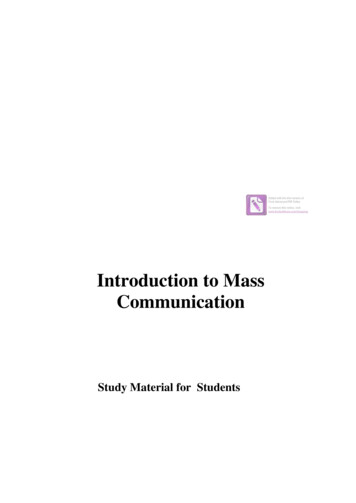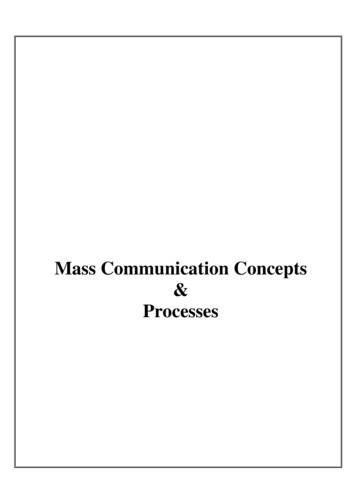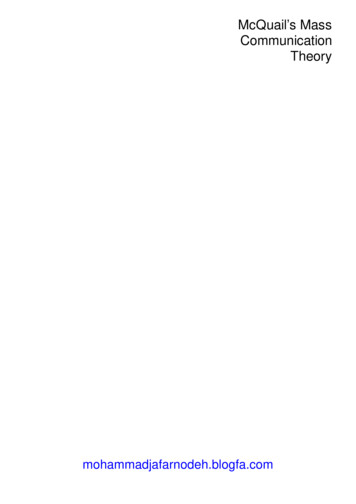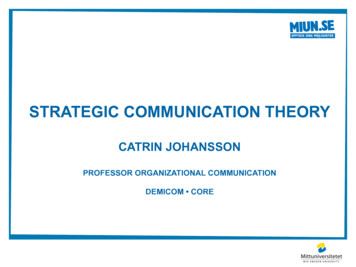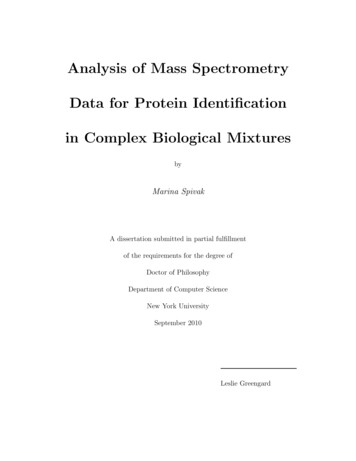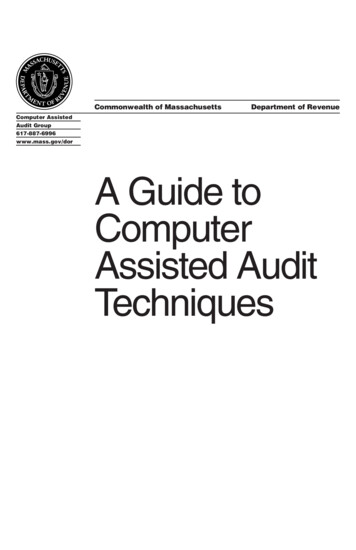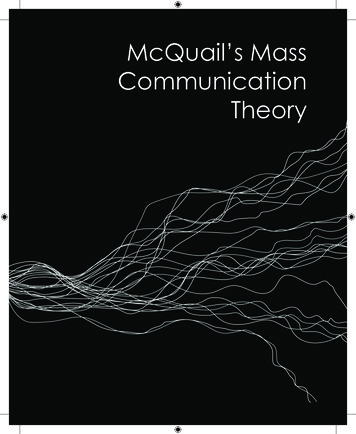
Transcription
McQuail’s MassCommunicationTheory
4Theory of Mediaand SocietyMedia, society and culture: connections and conflictsMass communication as a society-wide process: the mediation ofsocial relations and experienceA frame of reference for connecting media with societyTheme I: power and inequalityTheme II: social integration and identityTheme III: social change and developmentTheme IV: space and timeMedia–society theory I: the mass societyMedia–society theory II: Marxism and political economyMedia–society theory III: functionalismMedia–society theory IV: social constructionismMedia–society theory V: communication technology determinismMedia–society theory VI: the information societyConclusion80828587899193949598100101104107
80TheoriesIn this chapter, we look more closely at ideas about the relation between mass mediaand society, reserving the cultural implications for Chapter 5, even though society andculture are inseparable and the one cannot exist without the other. Treating society firstalso implies a primacy for society that is questionable, since the media and what theyproduce can also be considered as part of ‘culture’. In fact most media theory relatesto both ‘society’ and ‘culture’ together and has to be explained in relation to both. Forpresent purposes, the domain of ‘society’ refers to the material base (economic andpolitical resources and power), to social relationships (in national societies, communities, families, etc.) and to social roles and occupations that are socially regulated (formally or informally). The domain of ‘culture’ refers primarily to other essential aspectsof social life, especially to symbolic expression, meanings and practices (social customs,institutional ways of doing things and also personal habits).Most of the chapter is concerned with explaining the main theories or theoreticalperspectives that have been developed for understanding the way media work andaccounting for the typical cultural production that they engage in. Most of these theories do make the assumption that material and social circumstances are a primarydeterminant, but there is also scope for recognizing the independent influence thatideas and culture can have in their turn on material conditions. Before the theories ofmedia and society are considered, the main issues or broad themes that have framedinquiry into mass communication are described. A general frame of reference for looking at the connections between media and society is also proposed. First of all, wereturn in more detail to the conundrum of the relation between culture and society.Media, Society and Culture:Connections and ConflictsMass communication can be considered as both a ‘societal’ and a ‘cultural’ phenomenon. The mass media institution is part of the structure of society, and its technological infrastructure is part of the economic and power base, while the ideas, imagesand information disseminated by the media are evidently an important aspect of ourculture (in the sense defined above).In discussing this problem, Rosengren (1981b) offered a simple typology whichcross-tabulates two opposed propositions: ‘social structure influences culture’; andits reverse, ‘culture influences social structure’. This yields four main options thatare available for describing the relation between mass media and society, as shownin Figure 4.1.If we consider mass media as an aspect of society (base or structure), then theoption of materialism is presented. There is a considerable body of theory that viewsculture as dependent on the economic and power structure of a society. It is assumedthat whoever owns or controls the media can choose, or set limits to, what they do.This is the essence of the Marxist position.If we consider the media primarily in the light of their contents (thus more asculture), then the option of idealism is indicated. The media are assumed to have a
Theory of Media and SocietySocial structureinfluences ealism(strong mediainfluence)NoMaterialism(media aredependent)Autonomy(no casualconnection)Culture influencessocial structureFigure 4.1 Four types of relation between culture (media content) and societypotential for significant influence, but it is the particular ideas and values conveyedby the media (in their content) which are seen as the primary causes of social change,irrespective of who owns and controls. The influence is thought to work through individual motivations and actions. This view leads to a strong belief in various potentialmedia effects for good or ill. Examples include the promotion by the media of peaceand international understanding (or having the opposite effect), of pro- or antisocialvalues and behaviour, and of enlightenment or the secularization and modernizationof traditional societies. A form of idealism or ‘mentalism’ concerning media also liesbehind the view that changes in media forms and technology can change our way ofgaining experience in essential ways and even our relations with others (as in thetheories of McLuhan 1962, 1964).The two options remaining – of interdependence and of autonomy – have found lessdistinctive theoretical development, although there is a good deal of support in commonsense and in evidence for both. Interdependence implies that mass media and society arecontinually interacting and influencing each other (as are society and culture). The media(as cultural industries) respond to the demand from society for information and entertainment and, at the same time, stimulate innovation and contribute to a changing socialcultural climate, which sets off new demands for communication. The French sociologistGabriel Tarde, writing about 1900, envisaged a constant interweaving of influences:‘technological developments made newspapers possible, newspapers promote the formation of broader publics, and they, by broadening the loyalties of their members, create an extensive network of overlapping and shifting groupings’ (Clark, 1969). Today, thevarious influences are so bound together that neither mass communication nor modernsociety is conceivable without the other, and each is a necessary, though not a sufficient,condition for the other. From this point of view we have to conclude that the media mayequally be considered to mould or to mirror society and social changes.81
82**TheoriesThe option of autonomy in the relations between culture and society is not necessarily inconsistent with this view, unless interpreted very literally. It is at least very likelythat society and mass media can be independent of each other up to a point. Societiesthat are culturally very similar can sometimes have very different media systems. Theautonomy position also supports those who are sceptical about the power of the mediato influence ideas, values and behaviour – for instance, in allegedly promoting conformity, stimulating ‘modernity’ or damaging the cultural identity of poorer or less powerfulcountries. There are different views about how much autonomy in relation to societythe media can have. The debate is especially relevant to the central thesis of ‘internationalization’ or ‘globalization’, which implies a convergence and homogenization of aworldwide culture, as a result of the media. The autonomy position would suggest thatimported media culture is superficial and need not significantly touch the local culture.It follows that cultural imperialism is not likely to happen simply by chance or againstthe will of the culturally ‘colonized’ (see Chapter 10).An inconclusive outcomeAs with many of the issues to be discussed, there are more theories than there is solidevidence, and the questions raised by this discussion are much too broad to be settled byempirical research. According to Rosengren (1981b: 254), surveying what scatteredevidence he could find, research gives only ‘inconclusive, partly even contradictory,evidence about the relationship between social structure, societal values as mediatedby the media, and opinions among the public’. This assessment is just as valid thirtyyears later, suggesting that no single theory holds under all circumstances.It seems that the media can serve to repress as well as to liberate, to unite aswell as to fragment society, to promote as well as to hold back change. What is alsostriking in the theories to be discussed is the ambiguity of the role assigned to themedia. They are as often presented in a ‘progressive’ as in a ‘reactionary’ light, according to whether the dominant (pluralist) or alternative (critical, radical) perspectiveis adopted. Despite the uncertainty, there can be little doubt that the media, whethermoulders or mirrors of society, are the main messengers about society, and it is aroundthis observation that the alternative theoretical perspectives can best be organized.Mass Communication as a Society-wide Process:the Mediation of Social Relations and ExperienceA central presupposition, relating to questions both of society and of culture, is that themedia institution is essentially concerned with the production and distribution of knowledge in the widest sense of the word. Such knowledge enables us to make some sense of ourexperience of the social world, even if the ‘taking of meaning’ occurs in relatively autonomous and varied ways. The information, images and ideas made available by the media may,for most people, be the main source of an awareness of a shared past time (history) and of
Theory of Media and Societya present social location. They are also a store of memories and a map of where we are andwho we are (identity) and may also provide the materials for orientation to the future. Asnoted at the outset, the media to a large extent serve to constitute our perceptions and definitions of social reality and normality for the purposes of a public, shared social life, and area key source of standards, models and norms.The main thing to emphasize is the degree to which the different media have cometo be interposed between ourselves and any experience of the world beyond our immediate personal environment and our direct sensory observation. They also providemost of us with the main point of contact with the institutions of the society in whichwe live. In a secular society, in matters of values and ideas, the mass media tend to ‘takeover’ from the early influences of school, parents, religion, siblings and companions. Weare consequently very dependent on the media for a large part of our wider ‘symbolicenvironment’ (the ‘pictures in our heads’), however much we may be able to shape ourown personal version. It is the media which are likely to forge the elements which areheld in common with others, since we now tend to share much the same media sourcesand ‘media culture’. Without some degree of shared perception of reality, whatever itsorigin, there cannot really be an organized social life. Hjarvard (2008) sketches a theoryof social and cultural change in which the media gradually develop historically until theyemerge in the nineteenth century as an independent social institution. More recentlythis has developed further to become a means of integrating other social institutions.83The mediation conceptThese comments can be summed up in terms of the concept of mediation of contact withsocial reality. Mediation involves several different processes. As noted already, it refers tothe relaying of second-hand (or third-party) versions of events and conditions which wecannot directly observe for ourselves. Secondly, it refers to the efforts of other actors andinstitutions in society to contact us for their own purposes (or our own supposed good).This applies to politicians and governments, advertisers, educators, experts and authoritiesof all kinds. It refers to the indirect way in which we form our perceptions of groups andcultures to which we do not belong. An essential element in mediation as defined here is theinvolvement of some technological device between our senses and things external to us.Mediation also implies some form of relationship. Relationships that are mediatedthrough mass media are likely to be more distant, more impersonal and weaker thandirect personal ties. The mass media do not monopolize the flow of information wereceive, nor do they intervene in all our wider social relations, but their presence is inevitably very pervasive. Early versions of the idea of ‘mediation of reality’ were inclined toassume a division between a public terrain in which a widely shared view of reality wasconstructed by way of mass media messages, and a personal sphere where individualscould communicate freely and directly. More recent developments of technology haveundermined this simple division, since a much larger share of communication and thusof our contact with others and our environmental reality is mediated via technology(telephone, computer, fax, e-mail, etc.), although on an individual and a private basis.The implications of this change are still unclear and subject to diverse interpretations.
84TheoriesThompson (1993, 1995) has suggested a typology of interaction to clarify theconsequences of the new communication technologies that have detached socialinteraction and symbolic exchange from the sharing of a common locale. He notes(1993: 35) that ‘it has become possible for more and more individuals to acquireinformation and symbolic content through mediated forms of interaction’. He distinguished two types of interaction alongside face-to-face interaction. One of these,which he calls ‘mediated interaction’, involves some technical medium such aspaper, electrical wires, and so on, which enables information or symbolic content tobe transmitted between individuals who are distant in space or time or both. Thepartners to mediated interaction need to find contextual information as well havingfewer ones than in face-to-face contact.The other type is called ‘mediated quasi-interaction’ and refers to relations estab
Mass communication can be considered as both a ‘societal’ and a ‘cultural’ phenom-enon. The mass media institution is part of the structure of society, and its techno- logical infrastructure is part of the economic and power base, while the ideas, images and information disseminated by the media are evidently an important aspect of our culture (in the sense defined above). In .File Size: 1MBPage Count: 33
